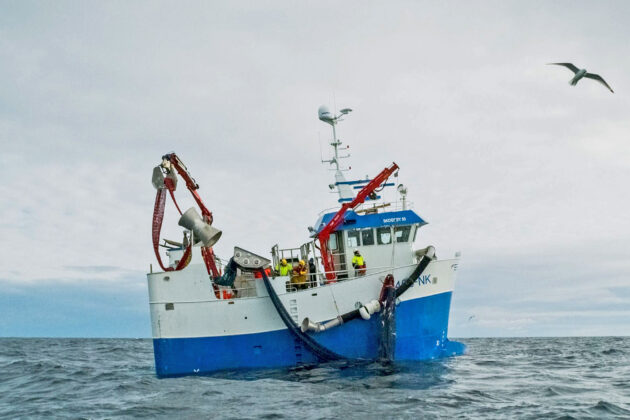Norwegian Fisheries socially sustainable – including fleets and industry

Serious violations of human rights, slavery and child labour are not present in the Norwegian fishing and seafood industry. Moreover, Norway has systems and regulations in place which address all issues raised internationally regarding social sustainability in the seafood industry.
This has now been affirmed through a new research report.
“Focus on social sustainability in the Norwegian seafood industry is becoming increasingly prevalent. And inspection and penalty systems are in place should there be instances where social sustainability requirements are not fulfilled,” says Nofima researcher Bjørg Helen Nøstvold.
Nøstvold led the research project Social sustainability in Norwegian fisheries – development and sustainability of fleets and industry in which Nofima, Fafo, and the University of Stirling, on behalf of the Norwegian Seafood Research fund (FHF), documented conditions in the Norwegian fishing industry with a focus on social sustainability.
Minimal risk
According to the report, which was authored by Bjørg Helen Nøstvold and Marianne Svorken from Nofima, Anne Mette Ødegård and Rolf Andersen from Fafo, and James A. Young from the University of Stirling, there is generally minimal risk of contraventions to regulations governing social sustainability in the Norwegian seafood industry. However, foreign labour runs a higher risk of being subjected to offences, such as social dumping, both in fishing fleets and in the on-shore processing industry.
“There have been several recent media reports concerning objectionable conditions experienced by foreign workers in Norwegian fleets and industry. Although we have laws and systems, there is always someone operating on the wrong side of the law. It’s a good thing that awareness of and focus on this is increasing, including in Norway,” says Nøstvold.
The results of the research should nevertheless be good news for the Norwegian seafood industry.
Tragic stories
Tragic stories of slavery, child labour and worker exploitation have grabbed the attention of the international community. This has, in turn, led to international customers of Norwegian seafood exporters also requesting documentation of working conditions and workers’ rights from their Norwegian suppliers – both from the fleets and on-shore industry.
The initiative for the FHF-funded project came from the fleet organisation Fiskebåt and from the Norwegian Fishermen’s Association. To contribute to the requested documentation, the recently-published report’s researchers described Norwegian legislation, inspection procedures, and penalty systems for safety, workers’ rights, and social security in the seafood industry.
“There are, of course, some challenges in the Norwegian seafood industry when it comes to the social rights of employees and how they are treated at some workplaces, but we can affirm that authorities and trade unions are steadfastly working towards improvements,” says Nøstvold.
She believes that this also stems from the initiatives undertaken by authorities through risk-based inspections and greater cooperation between the various inspection bodies. And Nøstvold also considers trade unions to play a crucial role in this cooperation.
Thorough understanding
The report is based on interviews with foreign purchasers, Norwegian inspection bodies, and representatives from the Norwegian Labour-Related Crimes Centre (A-Krim), statisticians, and reference groups, as well as meetings with representatives from fleets and industry, workers and employers.
In order to document and gain an in-depth, thorough understanding of how Norwegian laws, regulations, inspection bodies and sales organisations function, Nofima and the Fafo Institute for Labour and Social Research were tasked with charting the present social sustainability situation in Norway and the preferences and needs of international customers, and with preparing a report documenting the findings. Key concepts in the report include structure in the industry, national laws and regulations, Norwegian tripartite cooperation among workers, employers, and authorities, inspection systems and penalties, risk analysis and plans for future use, and updating of documents related to social sustainability in Norwegian fisheries and the fishing industry.
“A qualitative risk analysis was also carried out in which we identified and discussed areas where offences are most likely to exist, how these risk areas can be managed by public inspection systems, and how they can be monitored by trade unions. Lastly, the report describes the potential for improvement in public cooperation to further prevent offences. The conclusion drawn is that risks and monitoring must be viewed in a Norwegian context since social sustainability is spoken about in Norway to a much greater extent than it is internationally,” says Nøstvold.
Broad foundations
The work to chart social sustainability in the Norwegian seafood industry had broad foundations. A reference group appointed by FHF consisted of representatives from
- Fiskebåt
- The Norwegian Seafood Federation
- The Norwegian Union of Food, Beverage and Allied Workers (NNN)
- The Norwegian Seafarers’ Union
- The Norwegian Fishermen’s Association
- The Norwegian Coastal Fishermen’s Association
- The on-shore processing industry
“The reference group served in an advisory role in the project, but had no influence on the scientific quality or the results presented in the project,” underscores Nøstvold.
Facts about the Norwegian seafood industry
- The Norwegian seafood industry supplies 145 markets around the world, and is the world’s second largest exporter of seafood.
- Norwegian fishing fleets and the on-shore processing industry are among the most modern in the world.
- The industry employs more than 11,000 fishermen on more than 6,000 ships, and 9,000 production workers in 226 in industrial companies.
- The fisheries are particularly important to the rural districts along the Norwegian coast.
Publication
Contact person
Topics
Fisheries
